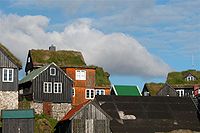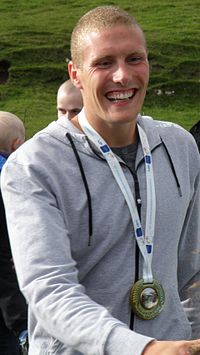- Culture of the Faroe Islands
-
 Traditional Faroese houses with turf roof in Reyni, Tórshavn. Most people build larger houses now and with other types of roofs, but the turf roof is still popular in some places.
Traditional Faroese houses with turf roof in Reyni, Tórshavn. Most people build larger houses now and with other types of roofs, but the turf roof is still popular in some places.
The culture of the Faroe Islands has its roots in the Nordic culture. The Faroe Islands were long isolated from the main cultural phases and movements that swept across parts of Europe. This means that they have maintained a great part of their traditional culture. The language spoken is Faroese. It is one of three insular Scandinavian languages descended from the Old Norse language spoken in Scandinavia in the Viking Age, the others being Icelandic and the extinct Norn, which is thought to have been mutually intelligible with Faroese. Until the 15th century, Faroese had a similar orthography to Icelandic and Norwegian, but after the Reformation in 1538, the ruling Danes outlawed its use in schools, churches and official documents. This maintained a rich spoken tradition, but for 300 years the language was not written down. This means that all poems and stories were handed down orally. These works were split into the following divisions: sagnir (historical), ævintyr (stories) and kvæði (ballads), often set to music and the mediaeval chain dance. These were eventually written down in the 19th century mostly by Danish scolars.
Contents
Music and Chain Dance
Traditional Faroese music was primarily vocal, and was not accompanied by musical instruments. Only in Tórshavn instruments like fiddles were present in the older days. When trade grew in the 20th century the Faroese started to use imported musical instruments. Much of the imported music and instruments remained popular only in the capital and largest city, Tórshavn. Rural peoples remained true to traditions of the chain dance and ballads. The chain dance is a dance, which only survived in the Faroe Islands, while in other European countries it was banned by the church, due to its pagan origin. The dance is danced traditionally in a circle, but when a lot of people take part in the dance they usually let it swing around in various wobbles within the circle.
The following description is by V. U. Hammershaimb, Færøsk Anthologi, 1891: The storyline of the ballad is attended by everybody with great interest, and if something especially pleasant or moving occurs, you can see it in the look and movement of the dancers – when the rage of the battle is described, the hands are clenched together, and when victory is in hand, they make cheering movements.
Such is the importance of the dance as a cultural element that the Faroese refer to it as Faroese dance. However, it shall be stated that the dance hasn’t the same popularity it once had. This especially applies to younger generations.
Literature and art
Faroese literature in the traditional sense of the word has only really developed in the past 100-200 years. This is mainly because the Faroese language was not written down in a standardised format until 1890 (in 1854 Venceslaus Ulricus Hammershaimb published a written standard for Modern Faroese that exists to this day. He produced orthography consistent with a continuous written tradition extending back to Old Norse). The Danish language was also encouraged at the expense of Faroese. Nevertheless, the Faroes have produced several authors and poets. The most famous of these authors are Jørgen-Frantz Jacobsen (known for his sole novel Barbara) and William Heinesen. Both authors wrote in Danish. Other famous authors from the Faroes include Heðin Brú (The Old Man and His Sons) and Jóanes Nielsen. Poets include the brothers Janus and Hans Andreas Djurhuus, and Rói Patursson. Both Heinesen and Patursson have been awarded The Nordic Council's Literature Prize.
As with literature, painting only really took off in the 20th century in the Faroes. Famous Faroese painters include Sámuel Joensen-Mikines, Ingálvur av Reyni, Ruth Smith, Tróndur Patursson, Steffan Danielsen and Amariel Norðoy among others.
Handcrafts
Lace knitting is a traditional handcraft of peoples of the Faroe Islands. The most distinguishing characteristic of Faroese lace shawls is the center back gusset shaping. Each shawl consists of two triangular side panels, a trapezoid-shaped back gusset, an edge treatment, and usually shoulder shaping.
Sports
 Pál Joensen after coming back home to his hometown Vágur after winning a silver medal at the 2010 European Aquatics Championships
Pál Joensen after coming back home to his hometown Vágur after winning a silver medal at the 2010 European Aquatics Championships
Football is the most popular sport on the Faroe Islands, closely followed by handball, volleyball and rowing. 60% of those who play sport on the islands play football. A 1-0 victory over Austria on 12 September 1990 still ranks as the greatest day in the history of football on the islands, but the national team has also recorded a number of impressive results against higher-ranked teams, primarily on home soil.
As of 1 July 2008, the Faroe Islands' international record (in UEFA European Championships qualifiers) was played 48, won 3, drawn 5, lost 40.[1]
Five different institutions run football schools, attended by 1,000 children each year. Todi Jónsson is probably the most famous player from the Faroe Islands of all times. He used to play for FC Copenhagen in Denmark and was the top scorer in the 2002/2003 season.[2]
The Faroe Islands compete in the biannual Island Games, which have been hosted by the islands in 1989.[3]
The Faroese freestyle swimmer Pál Joensen is the sportsperson of the Faroe Islands with the best international results until now (2011). In july 2011 he qualified for the finals in the men's 800 meters and 1500 meters freestyle at the 2011 World Aquatics Championships in Shanghai. He was number four in in 1500 meter free just 0,67 second after the bronze medalist.[4] He was number five in the men's 800 meters freestyle.[5] In 2010 Joensen won silver in 1500 meter freestyle in the European Championship 2010 (LC). His results are amazing especially considering that he lives in the Faroe Islands and trains in a 25 meter long pool because there is no 50 meter pool in the Faroe Islands (as of July 2011).
See also
- Faroese language
- Faroese literature
- Art of the Faroe Islands
- Music of the Faroe Islands
- Nordic House in the Faroe Islands
- Faroese dance
References
- ^ uefa.com - Football Europe
- ^ FIFA.com, Goal Programme - The Faroe Islands Football Association - 2001
- ^ Islandgames.net, Member profile, Faroe Islands
- ^ Omegatiming.com, Men's 1500m Freestyle, 14th FINA WORLD CHAMPIONSHIPS, Shanghai (CHN)
- ^ Omegatiming.com
Further reading
- Nauerby, Tom, and Dennis Gaffin. 1997. "No Nation Is an Island: Language, Culture, and National Identity in the Faroe Islands". American Anthropologist. 99, no. 3: 667.
- Wylie, Jonathan, and David Margolin. The Ring of Dancers Images of Faroese Culture. Symbol and culture. Philadelphia: University of Pennsylvania Press, 1981. ISBN 081227783X
External links
- faroearts – shows and sells the work of Faroese artists on the internet
Culture of Europe Sovereign
statesAlbania · Andorra · Armenia · Austria · Azerbaijan · Belarus · Belgium · Bosnia and Herzegovina · Bulgaria · Croatia · Cyprus · Czech Republic · Denmark · Estonia · Finland · France · Georgia · Germany · Greece · Hungary · Iceland · Ireland · Italy · Kazakhstan · Latvia · Liechtenstein · Lithuania · Luxembourg · Macedonia · Malta · Moldova · Monaco · Montenegro · Netherlands · Norway · Poland · Portugal · Romania · Russia · San Marino · Serbia · Slovakia · Slovenia · Spain · Sweden · Switzerland · Turkey · Ukraine · United Kingdom (England • Northern Ireland • Scotland • Wales) · Vatican City
States with limited
recognitionAbkhazia · Kosovo · Nagorno-Karabakh · Northern Cyprus · South Ossetia · Transnistria
Dependencies
and other territoriesÅland · Faroe Islands · Gibraltar · Guernsey · Jan Mayen · Jersey · Isle of Man · Svalbard
Other entities European UnionCategories:- Football in the Faroe Islands
- Faroese culture
Wikimedia Foundation. 2010.

